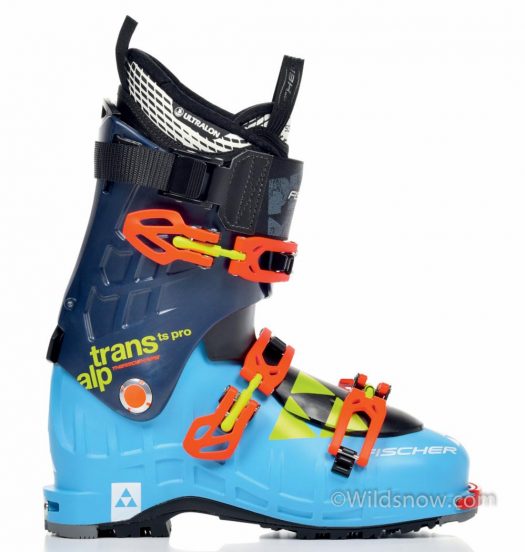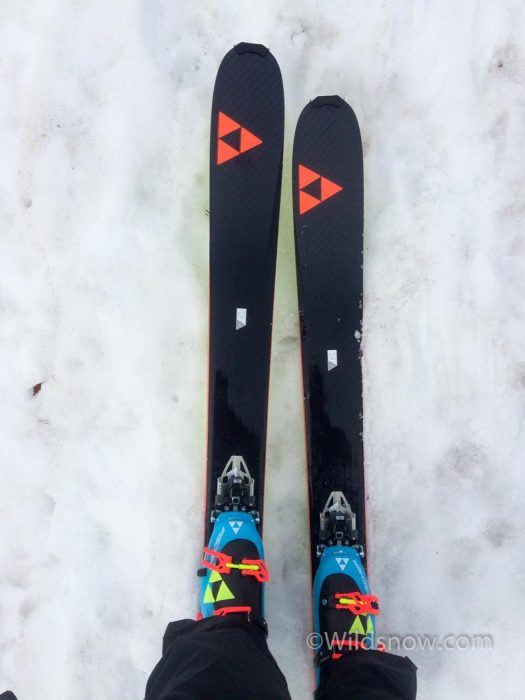Jackson Hole has had one of their best seasons in memory. Even so, we managed to visit (a press trip courtesy of Fischer) on what might have been their worst week of the year. Although the conditions didn’t quite line up to our blower pow expectations, we still had an excellent time. In a place as beautiful as the Tetons, it is hard not to.
I gave the Fischer Transalp TS Pro boots a try — Fischer’s beefiest AT boot. The boot is very similar to Fischer’s mid range Transalp TS Lite. The main differences are the plastic that it is molded from, the beefier power strap, and beefier buckles. The shell is made out of TPU, rather than the Vacu-plast of the TS Lite boot. This gives it much more stiffness, but unfortunately doesn’t allow the boot shell to be vacuum molded. The boot has been on the market since last fall with many reviews, so the focus here will be how it skied rather than what type of power strap it has.
I skied on the boots for two days: one day touring, and one day on Jackson Hole resort. Usually we refrain from putting up reviews of gear we have only tested for a few days. In this case, however, I got a good feel for the boots, and figured a bit of info would be helpful for anyone considering a purchase.
Our day of touring involved skiing that was difficult, to put it mildly. Warm temps and unconsolidated snow combined to create some of the most challenging skiing I’ve done in quite a while. Although our group consisted of very good skiers, and we were all struggling not to look like never-evers.
Although snow conditions weren’t ideal, I found out what the Transalp TS Pro boots can handle. Tiny “1 kilo” skimo boots weren’t going to cut it in this stuff. After a slushy experience, our legs were burning and I think we all said thanks that our ACLS were still intact.
The next day, we swallowed our backcountry skier pride and got tickets to ride the JMHR tram. The resort slopes had been beat into submission by an army of groomers and actually skied well; I guess those exorbitant ticket prices do go towards something useful. We ripped high-speed groomers, slammed slushy bumps, and generally had a blast. Our day on the resort gave me a better feel for how the boots perform in ski conditions that non-masochists enjoy.
Although the Transalp boots are purported to be 130 flex, I actually found them to ski fairly soft for a “beef” boot. Granted, in general I tend to ski the stiffest boots I can get my hands on, mostly just to prove something about my manliness. I’m sure the Fischer boot’s softness was partially a factor of the tropically warm temps we skied in. Indeed, the 2nd day we skied they felt a bit stiffer. Regardless, they certainly aren’t the stiffest thing out there when it comes to beefy touring boots (although still stiffer than lighter weight options). However, they do have a very nice, progressive flex that feels similar to an alpine boot. This is thanks to their all-plastic construction (no unyielding carbon), and probably the fact that they are made by an alpine boot company who employs demanding testers of the piste pounding persuasion.
Manufacturer’s specs for Fischer Transalp TS Pro:
Available sizes, 25.5 – 30.5
Shell and cuff material, TPU
Bootliner, Theroshape Tour
Last, 102mm
Tech fittings: Dynafit certified.
Weight, 1800g for size 26.5
MSRP, $699.99 US
Available at various etailers, may be somewhat out of stock until fall 2017.
Louie Dawson earned his Bachelor Degree in Industrial Design from Western Washington University in 2014. When he’s not skiing Mount Baker or somewhere equally as snowy, he’s thinking about new products to make ski mountaineering more fun and safe.


